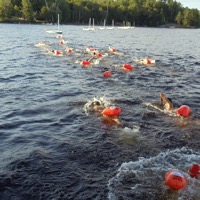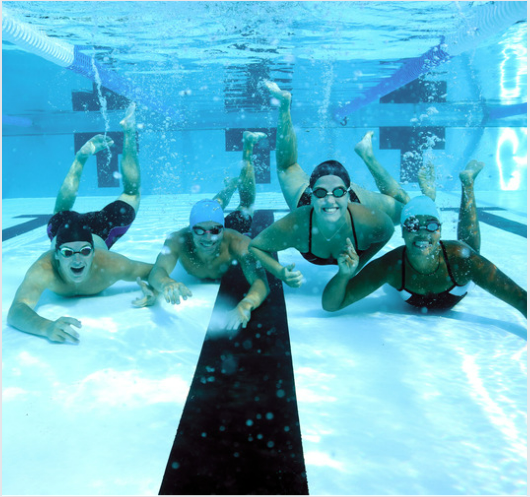Open Water Swimming Safety Tips For Everyone

Open Water
|
June 17, 2015
 1. Practice!
Get some real experience first. I’ve personally guarded open water swims and the most rescues occur within yards of the entry point. Don’t expect everything to go swimmingly on your first race without any practice towards it. Swim in lakes or the ocean prior to competing. It will help your confidence and alleviate fears that can weigh you down.
2. Relax
Don’t let your anxiety get the better of you. The last place you want to feel fear or panic is in the water. Keep your stroke long and your breathing even. Swim your race and no one else’s.
3. Buoys
In large crowds or smaller groups, a brightly colored bouy attached to you by a belt is an alert to boaters or other water enthusiasts to be aware of the swimmers. Their bright colors make them easy to spot and some of our own Kiefer SaferSwimmer Buoys have storage compartments.
4. Don’t Swim Alone
It’s just not a good plan. Always have a buddy. Even experienced or even elite swimmers can have an unexpected problem.
5. Hydrate/Fuel
Make sure your body is ready to work, hydrate up before you hit the water and make sure there is something of substance in your body to help you.
6. Sunscreen
Wear sunscreen. No excuses.
7. Vaseline/Body Glide
Use the gel to prevent blisters and uncomfortable chaffing from friction between your skin and your suit. If you are swimming in the ocean you don’t want that raw skin getting irritated further by salt water. Note: If you are wearing a wetsuit made of neoprene Vaseline will eventually cause it to decompose.
8. Bad weather
Be wary of storms, especially when swimming in the ocean. A quick change in the winds could have you battling some scary waves. Lightning as well. If there is call for lightning best to avoid large bodies of water.
9. Currents
They can sneak up on you. First step is don’t panic, second step is don’t fight it. Let the current carry you until it weakens enough for you to get free and back on track.
10. Warm up
Jog first, do some light stretching and dry land activities, but don’t jump in the water and push the ‘go fast’ button right away. Let your muscles get ready for the work and prepare them properly.
11. Goggles
The last thing you want to do is stop and fiddle with your goggles. I suggest layering them under your cap for extra security.
12. Sighting
Practice siting in advance so you can minimize the number of times you have to check where you are during a race. Get proficient at picking a spot and swimming a straight line without having to follow a line on the bottom of the pool.
If you plan on going open water swimming, be sure to check out our SaferSwimmer™ Buoy: a brightly colored, lightweight, inflatable device with waist belt that visibly floats behind a swimmer in open bodies of water, making the swimmer more visible to lifeguards, boaters and other open water vehicles.
1. Practice!
Get some real experience first. I’ve personally guarded open water swims and the most rescues occur within yards of the entry point. Don’t expect everything to go swimmingly on your first race without any practice towards it. Swim in lakes or the ocean prior to competing. It will help your confidence and alleviate fears that can weigh you down.
2. Relax
Don’t let your anxiety get the better of you. The last place you want to feel fear or panic is in the water. Keep your stroke long and your breathing even. Swim your race and no one else’s.
3. Buoys
In large crowds or smaller groups, a brightly colored bouy attached to you by a belt is an alert to boaters or other water enthusiasts to be aware of the swimmers. Their bright colors make them easy to spot and some of our own Kiefer SaferSwimmer Buoys have storage compartments.
4. Don’t Swim Alone
It’s just not a good plan. Always have a buddy. Even experienced or even elite swimmers can have an unexpected problem.
5. Hydrate/Fuel
Make sure your body is ready to work, hydrate up before you hit the water and make sure there is something of substance in your body to help you.
6. Sunscreen
Wear sunscreen. No excuses.
7. Vaseline/Body Glide
Use the gel to prevent blisters and uncomfortable chaffing from friction between your skin and your suit. If you are swimming in the ocean you don’t want that raw skin getting irritated further by salt water. Note: If you are wearing a wetsuit made of neoprene Vaseline will eventually cause it to decompose.
8. Bad weather
Be wary of storms, especially when swimming in the ocean. A quick change in the winds could have you battling some scary waves. Lightning as well. If there is call for lightning best to avoid large bodies of water.
9. Currents
They can sneak up on you. First step is don’t panic, second step is don’t fight it. Let the current carry you until it weakens enough for you to get free and back on track.
10. Warm up
Jog first, do some light stretching and dry land activities, but don’t jump in the water and push the ‘go fast’ button right away. Let your muscles get ready for the work and prepare them properly.
11. Goggles
The last thing you want to do is stop and fiddle with your goggles. I suggest layering them under your cap for extra security.
12. Sighting
Practice siting in advance so you can minimize the number of times you have to check where you are during a race. Get proficient at picking a spot and swimming a straight line without having to follow a line on the bottom of the pool.
If you plan on going open water swimming, be sure to check out our SaferSwimmer™ Buoy: a brightly colored, lightweight, inflatable device with waist belt that visibly floats behind a swimmer in open bodies of water, making the swimmer more visible to lifeguards, boaters and other open water vehicles. 






Leave a Comment
Your email address will not be published. Required fields are marked *